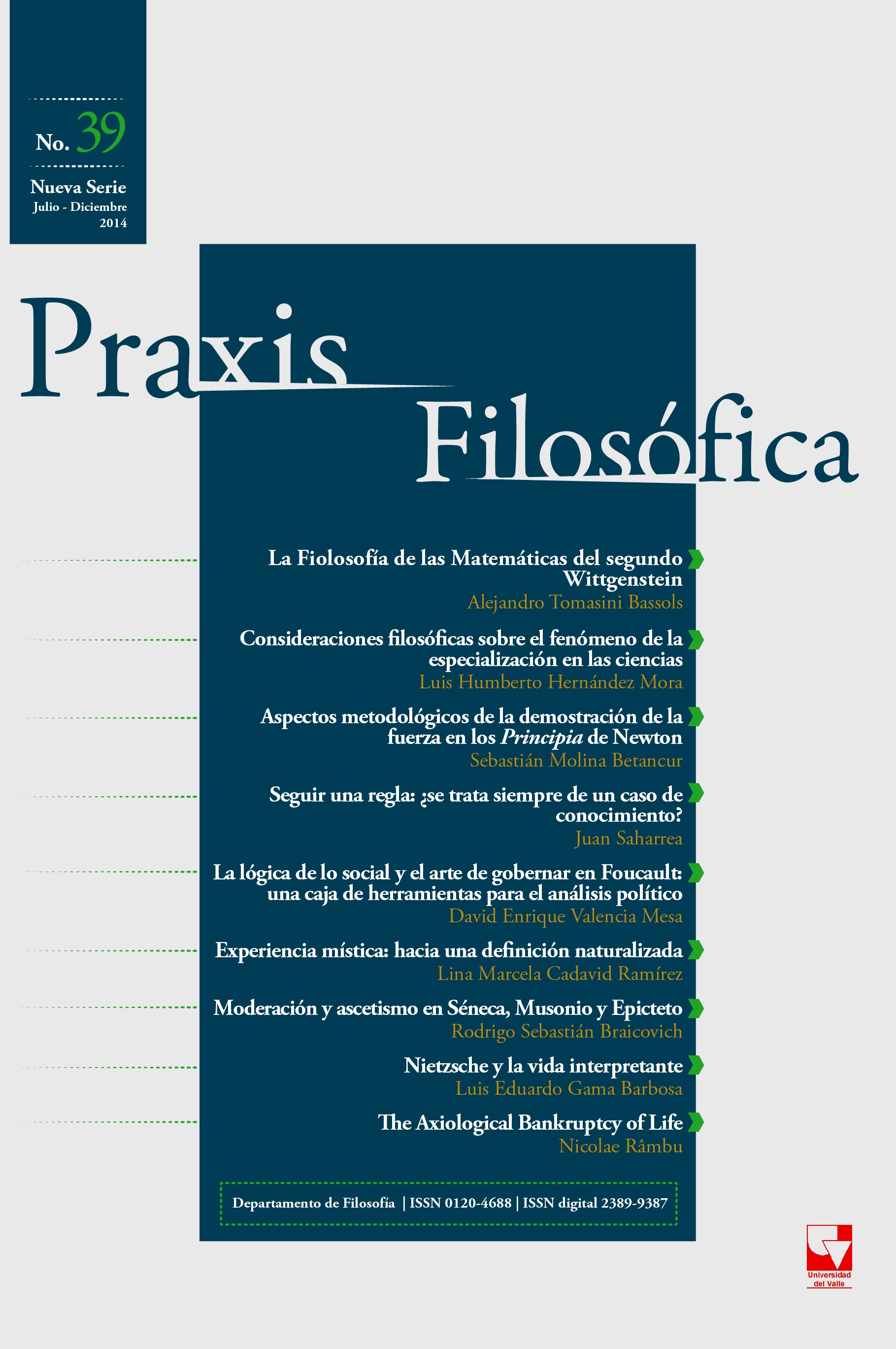Methodological aspects of the demonstration of the force in Newton's Principia
Main Article Content
Before the continental mechanical philosophy’s critics, which characterized the gravitational force as an “occult quality” Newton wrote at the “General Scholium” a short answer in which he said that force is real and it was enough the explication given in the Principia to hold like that. About that two interpretations have pretended to explain what are the methodological and mathematical aspects of Newton’s answer. In this article it’s shown that the most recent reading of this problem allows us to understand some of the limitations of the classical interpretation, when it emphasizes the methodological aspect of the demonstration, highlighting the relation between mathematics and natural philosophy proposed in the “Preface to the reader” of the first edition of Newton’s Principia.
- Occult quality
- gravitational force.
- natural philosophy
- analysis and synthesis
- manifest quality
- gravitational force
Cohen, I. B. (1987). Newton’s third law and universal gravitation. Journal of the History of Ideas, 48 (4), 571-593.
Cohen, I. B. (1999). A Guide to Newton’s Principia. En Newton, I. The Principia. Mathematical Principles of Natural Philosophy (pp. 1-370). Cohen, I. B. & Whitmann, A. (Trad.). Budenz, J. (Asis.). Berkeley: University of California Press.
Cohen, I. B. (2002). Newton’s concepts of force and mass, with notes on the Laws of motion. En Cohen, I. B. & Smith G. E. (Eds.). The Cambridge Companion to Newton (pp. 57-84). Cambridge: Cambridge University Press.
Cohen, I. B. & Smith G. E. (Eds.). (2002). The Cambridge Companion to Newton. Cambridge: Cambridge University Press.
Ducheyne, S. (2006). “The argument(s) for universal gravitation”. En Foundations of Science, Vol. 11, pp. 419-447.
Ducheyne, S. (2012). The Main Business of Natural Philosophy. Isaac Newton’s Natural Philosophical Methodology. Dordrecht: Springer.
Garrison, J. W. (1987). Newton and the relation of mathematics to natural philosophy. Journal of the History of Ideas, 48(4), 609-627.
Guerlac, H. (1973). Newton and the method of analysis En Wiener, P. (Ed.). Dictionary of the history of ideas (pp. 378-391). Vol. 3. New York: Charles Scribner’s sons.
Guerlac, H. & M. C., Jacob. (1969). Bentley, Newton, and providence: The Boyle Lectures once more. Journal of the History of Ideas, 30(3), 307-318.
Guicciardini, N. (1998). Did Newton use his calculus in the Principia? Centaurus, 40(3-4), pp. 303-344.
Guicciardini, N. (1999). Reading the Principia: The Debate on Newton’s mathematical Methods of Natural Philosophy from 1687 to 1736. Cambridge: Cambridge University Press.
Guicciardini, N. (2002). Analysis and synthesis in Newton’s mathematical work. En Cohen, I. B. & Smith, G. E. (Eds.), The Cambridge Companion to Newton (pp. 308-328) Cambridge: Cambridge University Press.
Harper, W. L. (2002). Newton’s argument for universal gravitation. En Cohen, I. B. & Smith, G. E. (Eds.), The Cambridge Companion to Newton (pp. 174-201) Cambridge: Cambridge University Press.
Harper, W. L. (2011). Isaac Newton’s scientific method. Turning data into evidence about gravity and cosmology. New York: Oxford University Press.
Janiak, A. (2000). Space, atoms and mathematical divisibility in Newton. Studies in History and Philosophy of Science, 31(2), 203-230.
Janiak, A. (2004) Introduction to Newton: Philosophical Writings. En Newton, I. (2004) Newton: Philosophical Writings. Janiak, A. (Ed.) (2000), pp. ix-xxxi.
Janiak, A., Schliesser, E. (Eds.). (2012). Interpreting Newton. Critical Essays. New York: Cambridge University Press.
Koyré, A. (1965). Newtonian Studies. London: Chapman and Hall.
Newton, I. (1962). Unpublished Scientific Papers of Isaac Newton. A Selection from the Portsmouth Collection in the University Library of Cambridge. Hall, A. R. & Hall, M. B. (Eds.). Cambridge: Cambridge University Press.
Newton, I. (1965a). De motu corporum in gyrum. En Herivel, J. (1965). The Background to Newton’s ‘Principia’. A Study of Newton’s Dynamical Researches in the Years 1664-1684. EnHerivel, J. Oxford: Clarendon Press.
Newton, I. (1965b). De motu Corporum in Mediis Regulariter Cedenbitus. MS. Add. 3965. En Herivel, J. The Background to Newton’s ‘Principia’. A Study of Newton’s Dynamical Researches in the Years 1664- 1 6 8 4 .Oxford: Clarendon Press.
Newton, I. (1977). Óptica o Tratado de las Reflexiones, Refracciones, Inflexiones y Colores de la Luz. Solís, C. (Trad.). Madrid: Alfaguara.
Newton, I. (1987). Principios Matemáticos de la Filosofía Natural. Escohotado, A. (Trad.). Barcelona: Tecnos.
Newton, I. (1999) The Principia. Mathematical Principles of Natural Philosophy. Cohen, I. B. & Whitmann, A. (Trad.). Budenz, J. (Asis.). Berkeley: University of California Press.
Newton, I. (2003). Opticks, or, A Treatise of the Reflections, Refractions, Inflections, and Colours of Light. New York: Prometheus Books.
Spencer, Q. (2004). Do Newton’s rules of reasoning guarantee truth... must they?. Studies of History and Philosophy of Science, 35, pp. 759-782.
Downloads
De acuerdo con nuestra política (Licencia Creative Commons CC BY-NC-SA 4.0) los artículos presentados y sometidos al proceso editorial en la revista Praxis Filosófica no tienen costo alguno para sus autores ni retribuciones económicas para la revista. El artículo de carácter inédito, producto de investigación o de algún proyecto que se presente a Praxis Filosófica, no podrá estar sometido a otro proceso de publicación durante el proceso que se lleve en nuestra revista.





